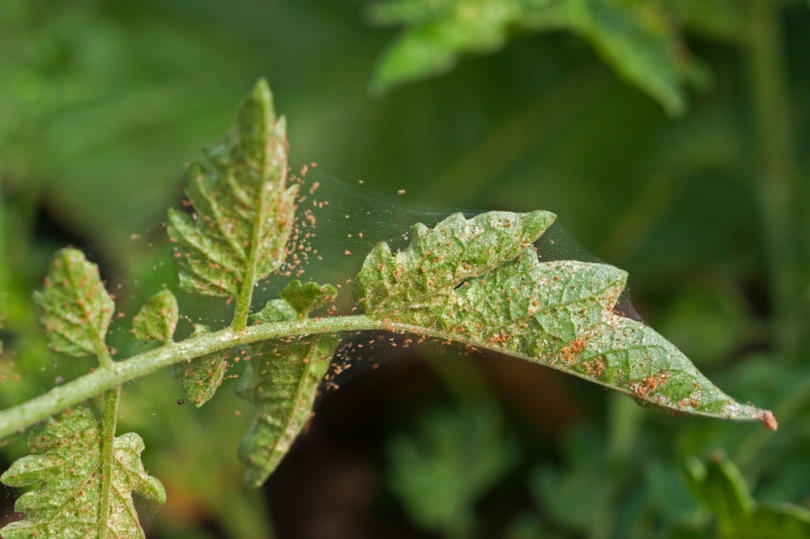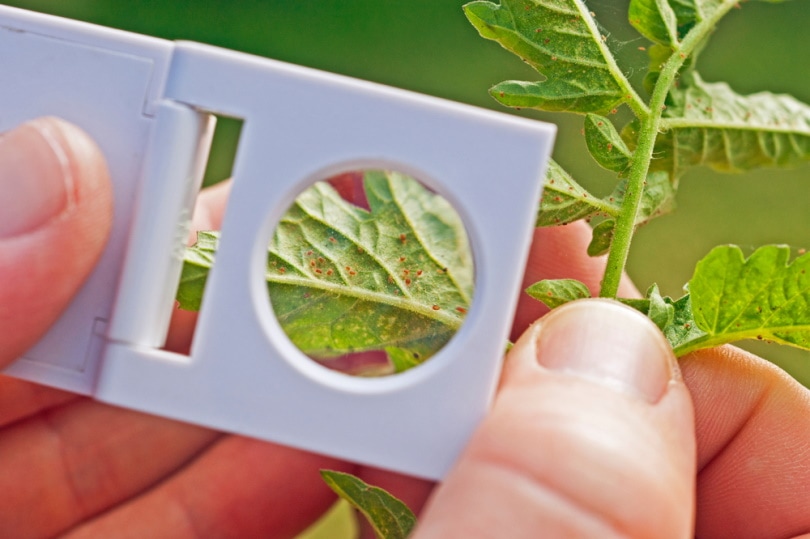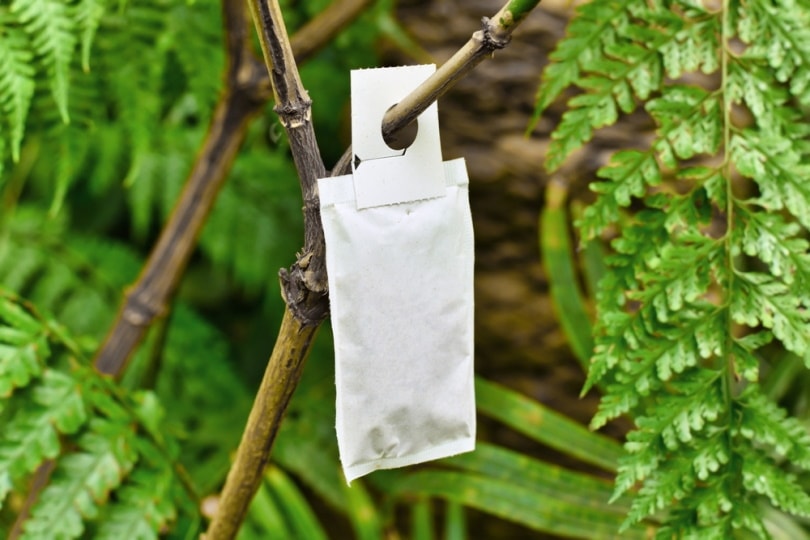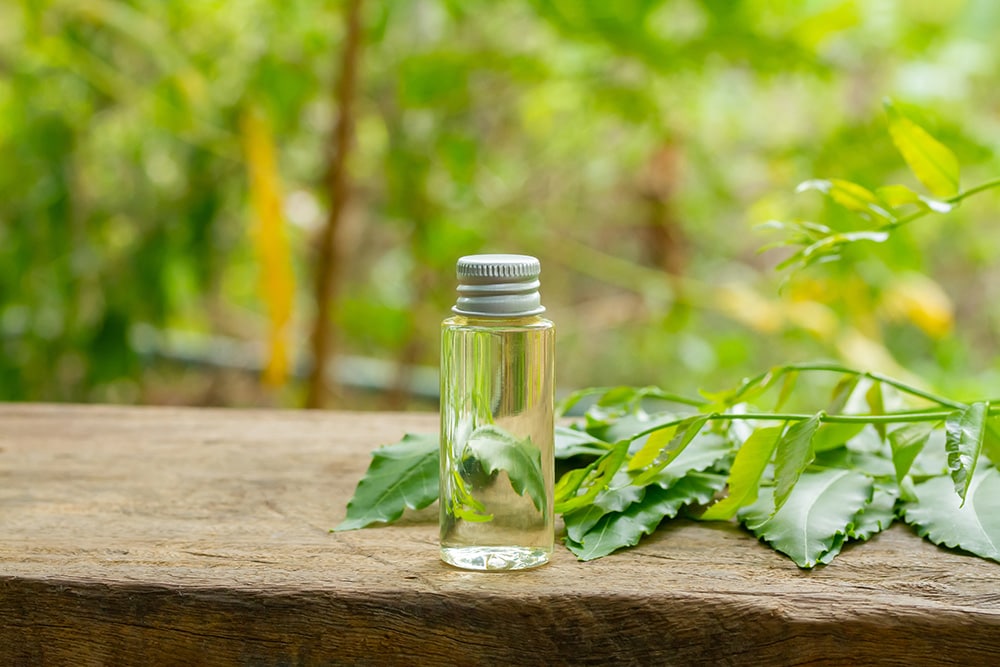How to Get Rid of Spider Mites on Indoor Plants: 11 Tips & Tricks
-
Pete Ortiz
- Last updated:

Spider mites are one of the most prevalent threats to our favorite plants. Tiny and aggressive, these pests can do extensive damage to outdoor gardens and indoor houseplants, growing into massive populations before you even know they’re there.
Prevention is crucial in the fight against spider mites. With a few clever and eco-friendly solutions, winning the battle can be surprisingly easy. Follow these essential insights, tips, and tricks to eliminate spider mites on your indoor plants and keep them away for good.
What Are Spider Mites?
Spider mites are arachnids, bearing a shape similar to a tick in adulthood. They begin their five-stage life cycle as orb-shaped translucent eggs, which females lay on the underside of host plant leaves. After hatching, the six-legged larvae feed on the plant until they develop into eight-legged nymphs and eventually adults.
Adult spider mites have oval-shaped bodies measuring roughly 1/50 of an inch (½ mm). They typically have a white or translucent color, but mites may also be brown, orange, red, black, or green, depending on their diet.
While some of the hundreds of spider mite species enjoy cool weather, the most common household pests, such as the two-spotted spider mite, prefer hot, dusty, and dry environments. Under optimal conditions and with a decent food supply, spider mites can go from egg to adulthood in less than a week.
Warm weather inspires feeding and egg-laying. Mites become especially active from June through September, and females can lay over 100 eggs in only a few weeks.
During the winter, spider mites will become dormant as temperatures drop and food becomes scarce. Outdoor females typically turn reddish-brown and overwinter under tree bark or ground debris. But indoors, spider mites may get help from your heating system, using the warmer, drier conditions to remain a year-round nuisance.

How Do Spider Mites Get In?
Spider mites hang out in dusty areas, congregating on trees and plants near roadways and gardens. They have a varied diet of over 300 plant species, preferring leafy, nutrient-rich plants. Water-stressed plants are their favorite targets.
After running through their food supply, spider mites move on in search of new territory. Being so small and light, they use their webbing to travel on wind currents to the next plant. They may even blow through your window screen to attach to indoor plants. Outside, they might grab onto a plant, a pet, or your clothing to hitch a ride inside.
Signs & Symptoms of Spider Mite Damage
Spider mites can quickly establish a thriving colony in a matter of weeks. Although they’re nearly imperceptible to the naked eye, an accumulation of mites and their waste may appear as fine powdery dust on your plant leaves.
Before you notice the mites themselves, you’ll likely spot their telltale silk webbing wound around the undersides of leaves and stems. Webbing typically becomes apparent around the same time that obvious signs of damage emerge in the plant’s leaves.
Spider mites suck on plant cells to drain their sap. Leaves take on a stippled appearance as the mites feed on their fluids, developing bronze-colored spots and open holes over time. They eventually become shriveled, turning yellow or red before finally dropping off.

What Plants Do Spider Mites Prefer?
While we can’t list off the hundreds of plants that may fall victim to spider mites, certain conditions and characteristics make some more susceptible. Water-starved plants and those in direct sunlight are particularly prone to developing spider mite infestations.
Spider mites also enjoy plants high in nutrients like phosphorus and nitrogen. High nitrogen levels in over-fertilized plants can yield “funny proteins,” compounds that create sweeter sap, which attracts more pests.
Hydroponic setups can also attract spider mites. Despite the higher humidity, which mites typically don’t like, the temperature and food supply will allow them to flourish.
 The 11 Tips & Tricks on How to Get Rid of Spider Mites on Indoor Plants
The 11 Tips & Tricks on How to Get Rid of Spider Mites on Indoor Plants
Spider mite populations can double in only a couple of weeks, and they can do significant harm in a short time. It’s crucial to regularly monitor plants for signs of spider mites and take swift action as soon as you notice activity.
Once you start seeing damage, look for movement around the webbing. You can also try holding a piece of paper under a leaf and shaking it to see if any mites fall. They may have moved on by the time you notice their impact. When there has not been extensive damage, plants usually recover after the mites leave.
If you find a live colony, follow these 11 tips and tricks to quickly and efficiently remove spider mites and prevent future attacks on your indoor plants.
1. Separate the Plants

Before attempting to fix an affected plant, you first need to isolate it from your other plants to prevent further spreading. Inspect any nearby plants and pull any that seem suspect. Move them to a cool, humid area for treatment. You may consider pruning overly infested leaves if it won’t harm the plant, removing them carefully and placing them in a sealed plastic bag to make the remaining treatment easier.
2. Wash the Plant Foliage
Take your plant to your bathtub or a sink to wash the affected leaves. Use a soft cloth to wipe down the plant and clear away webbing to help your cleaning solution do its job.
You can also use a jet of water to remove spider mites in a tactic called syringing. In nature, heavy rain is often enough to dislodge mites from their host plant. With a powerful enough spray head, syringing can be a go-to population control method whenever you’re worried about an infestation.
Create an insecticidal soap by mixing 1 liter of lukewarm water with a couple of drops of liquid dish soap. Mix the solution in a spray bottle and douse the plant to kill the infestation. Wipe down the leaves and rinse the plant thoroughly to remove the cleaner and any dead mites.
Wash your indoor plants frequently to prevent future pest buildup, paying close attention to the undersides of leaves.
3. Use Rubbing Alcohol

Rubbing alcohol won’t damage your plants when you mix it with the right amount of water, but it will make an effective miticide. Mix the ingredients in a spray bottle, using 1 part alcohol to 3 parts water for delicate plants and a 1:1 ratio for hardier species.
You can spritz the cleaner directly on the leaves and allow it to evaporate. For the best results, soak a clean cloth in the solution and wipe the leaves to kill and remove the spider mite infestation. Miticides only work if they make contact with the mites, and wiping down leaves ensures better coverage.
4. Treat the Plant with Plant-Based Insecticides
Try commercial petroleum-based or plant-based miticides if your home remedies aren’t working. Pyrethrin, a natural compound derived from chrysanthemum flowers, is a potent insecticide that targets a spider mite’s nervous system.
While generally effective, misuse of pyrethrin may exacerbate a spider mite problem. Spider mites develop immunities quickly, so strict reliance on pyrethrin may have a waning effect. Its non-selective insect prevention also eliminates beneficial predators that can control spider mite populations. Some pyrethrins even boost nitrogen levels in the plants, giving spider mites even more reason to attack your plants.
5. Apply Horticultural Oils

Horticultural oils containing cottonseed, soybean, sesame, or canola oil are excellent organic alternatives to pyrethrin sprays. These products work primarily by smothering spider mites (and nearly any other insect they touch), evaporating harmlessly after a few days. Other plant extracts with pesticidal benefits include:
- Garlic extract
- Rosemary oil
- Cinnamon oil
- Clove oil
- Mint oil
You can find these additives in many commercial insecticidal sprays, such as Mite-X or GrowSafe. Although oils are effective, you typically will need to respray your plants every 3–9 days to eliminate a spider mite infestation.
Even organic spider mite treatments, particularly plant-based oils, can burn your plants. Prevent injury by testing new products on 1–2 leaves to see how the plant reacts. Avoid using insecticidal oils if the plant is dried out or the temperature is over 90°F.
No matter which product you try, always read the application instructions. While many horticultural oils work during the active summer season to kill adult mites, dormant oils work in the fall and spring to eliminate overwintering females and new eggs. If you use them at the wrong time of year, you risk damaging your plants or aiding spider mite population growth.
6. Cycle Out Treatment Methods
Spider mites can build a resistance to miticides if you use the same ones repeatedly. Use a diverse array of natural products, changing them occasionally to keep the mites from becoming too comfortable.
7. Bring in Predatory Mites
A convenient, safe, and effective alternative to manually spraying spider mites is to bring in some of their natural enemies.
- Western predatory mite (Galendromus occidentalis)
- Phytoseiulus persimilis
- Amblyseius cucumeris

You can purchase many of these at gardening stores or online. These predators feed exclusively on mites and other pests like thrips while leaving your plants alone. After running through their food source, predators either die off or migrate to another hunting ground.
Though less effective, other insects like lacewing larvae, ladybugs, and various types of thrips can also be beneficial in preventing mites. As with insecticide sprays and oils, it is crucial to check the usage information for each predator. Predators may be ineffective or even harmful if used on the wrong plant or in the wrong climate conditions.
Be careful using sprays and other treatments alongside predator species since non-selective agents could kill your helpers. Only use products that target spider mites, or use insecticides as a precursor to predator mites.
Using predator mites as a preventative measure is often more practical than using them to reduce populations. You want roughly one predator mite for every 10 spider mites. If the infestation is extreme, use an insecticide to bring the spider mite numbers down before employing predator mites. You may need to reintroduce them on occasion, but some predators stick around indefinitely to control recurring threats.
8. Remove the Affected Plant
A severe infestation and extensive plant damage may force you to dispose of your plant. Place a plastic bag over the plant to trap the spider mites, and toss it in an outside garbage can. Check your remaining plants for signs of mite damage and treat them as needed.
9. Prevent Spider Mites with Neem Oil

Neem oil is a natural derivative of the neem evergreen tree. Like other horticultural oils, neem oil kills spider mites while protecting plants. It works slowly, and its ideal application is as an ongoing preventative treatment.
You can buy neem oil products such as Natria’s Neem Oil Spray or formulate a DIY natural repellant. Mix ½ tsp of neem oil with your homemade insecticide (1 liter lukewarm water + 1 tsp mild soap) in a spray bottle. Spray your plants with the solution and reapply it every 7–10 days until the spider mites are gone.
Neem oil may be too thick to use on hydroponic plants. Look for products that feature its active ingredient, azadirachtin, in thinner solutions to prevent damage to your equipment.
10. Inspect and Debug New Plants
The best way to avoid spider mite problems is to keep them from infiltrating the house, and that starts with inspecting your plants. Before bringing plants in from a garden center or your backyard, check for yellowing leaves, webbing, and other signs of infestations.
11. Take Care of Your Plants to Keep Spider Mites Away

You can prevent spider mites or at least slow their progress by taking away their ideal living conditions. Frequent dusting is an essential habit. Wipe your plants’ leaves with a damp cloth to remove dust and spider mite eggs, add moisture, and promote better sunlight absorption.
Deter spider mites by keeping the humidity up and watering your plants. Check the soil regularly and add water if the top ½ inch is dry. Use a soil moisture gauge to help you keep your plants adequately watered, and avoid direct sunlight if it risks heating up and drying out your plants.
Conclusion
Plants are remarkably resilient, but they’re also susceptible to a broad range of everyday hazards. They require constant monitoring for common pests, particularly aggressive dangers like spider mites.
Luckily, if you provide adequate care and plenty of water, you’re already doing your part to deter the microscopic pests. When spider mites start to get out of hand, you have more than enough natural solutions available to safely and effectively keep them at bay.
Featured Image Credit: Catherine Eckert, Shutterstock
Contents


 The 11 Tips & Tricks on How to Get Rid of Spider Mites on Indoor Plants
The 11 Tips & Tricks on How to Get Rid of Spider Mites on Indoor Plants